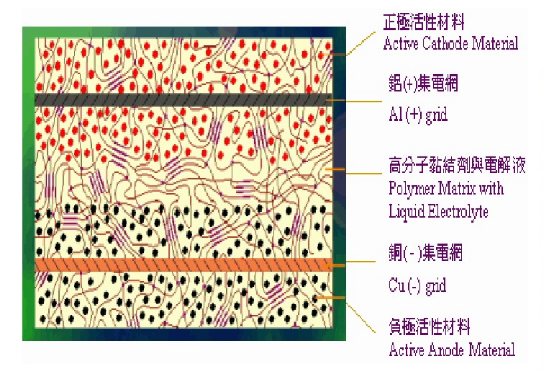In today’s era, our dependence on batteries is increasing day by day. Whether it is electric cars traveling through the streets or portable electronic devices that people use every day, they are inseparable from the support of batteries. For this reason, the issue of battery degradation has become increasingly important.
Battery Positive and Negative Electrodes
Part I: What is Battery Degradation?
Battery degradation refers to the phenomenon that the performance and capacity of a battery decrease over time. This decline can be caused by the following reasons:
●Chemical reactions: Every time a battery is charged and discharged, chemical reactions occur in its internal cells. Over time, these reactions can produce some harmful compounds that reduce the efficiency of the battery.
●Physical changes: Repeated charge and discharge cycles cause structural changes in the materials inside the battery. This can lead to the formation of dendrites – tiny needle-like structures that cause short circuits.
●Temperature effects: Extreme temperatures accelerate battery degradation. High temperatures speed up chemical reactions, while low temperatures slow down the movement of ions in the battery.
Part 2: How does battery chemistry affect performance degradation?
Battery chemistry has a significant impact on its lifespan and performance. Lithium-ion batteries are widely used in many devices today, but they are particularly susceptible to performance degradation because they rely on lithium ions moving between the anode and cathode.
●Lithium ion movement: During charging, lithium ions move from the cathode to the anode; during discharge, they return to the cathode. Over time, some lithium ions may become trapped in inactive areas within the battery. This ion trapping can lead to capacity loss because the ions can no longer participate in the charge and discharge process.
●Electrolyte decomposition: The electrolyte in lithium-ion batteries degrades over time due to chemical reactions with other materials in the cell. This decomposition reduces conductivity and increases internal resistance, which further affects battery performance.
Part 3: Can battery degradation be reversed?
While it may be impossible to completely reverse battery degradation due to irreversible chemical changes, recent research has shown some promising methods to partially restore battery capacity:
●Reactivate inactive lithium: A Stanford University study showed that isolated lithium in a battery can be mobilized back to the electrodes through a specific charging protocol. This process has the potential to restore up to 30% of the battery’s lost capacity.
●Optimize charging techniques: Users have reported that battery performance has improved by adjusting their charging habits (such as changing the charge level or occasionally performing a full charge cycle), which may help balance cell activity and mitigate further performance degradation.
These findings suggest that while we cannot completely reverse battery degradation, we can take steps to optimize battery performance and extend battery life.

Battery Positive and Negative Molecules
Part 4: What are some tips for maintaining battery health?
To extend battery life and minimize performance degradation, consider using these tips:
●Avoid extreme temperatures: Keep the battery in a suitable temperature environment as much as possible. Avoid leaving your device in a hot car or exposing it to freezing cold. High temperatures can accelerate chemical reactions that can cause battery degradation.
●Charge properly: Instead of charging your device to 100% every time, consider charging it to about 80% each day. This reduces stress on the battery and helps maintain its health over time.
Cycle the battery regularly: Occasionally let the battery fully discharge before charging it. Doing so helps recalibrate the battery management system (BMS) and may improve the accuracy of battery capacity readings.
Part 5: What are the latest advances in reversing battery degradation?
Recent advances in battery technology have opened up new avenues to address battery degradation:
●Fast discharge technology: Researchers have found that a fast discharge step after charging can help move inactive lithium back to active areas within the cell. This technique has the potential to restore some of the lost battery capacity.
●New materials: Innovations in materials science have led to the development of more robust electrodes that resist dendrite formation and other forms of degradation. These new materials are expected to significantly improve the overall life of the battery.
●Battery Management System (BMS): Enhanced BMS technology can better monitor and manage charging cycles, and it can optimize usage patterns based on real-time data, which can help extend the overall life of the battery.
Part 6: How does user behavior affect battery life?
User behavior has a significant impact on the speed at which battery performance degrades:
●Charging habits: Frequent use of fast charging features or leaving the device plugged in overnight will accelerate battery wear. It is best to charge the device when the battery is down to about 20% rather than waiting until the battery is completely drained or leaving the device charging overnight.
●Usage patterns: High-energy applications that require continuous power consumption will also cause battery performance to degrade faster. If you often use power-intensive applications or features, consider using them less, if possible.
Part 7: Are there some misconceptions about reversing battery performance degradation?
There are some misconceptions about reversing battery performance degradation:
●Myth 1: You can completely restore the original capacity of a degraded battery.
Reality: While some methods may be able to restore some capacity, full recovery is generally not feasible due to irreversible chemical changes within the cell.
●Myth 2: All batteries degrade at the same rate.
Reality: Different chemistries and usage patterns cause different types of batteries to degrade at different rates. Lithium-ion batteries may degrade differently than nickel-cadmium or lead-acid batteries.
Understanding these myths can help us set realistic expectations for battery recovery based on current technology and practices.
Part 8: How are manufacturers addressing battery degradation?
Manufacturers are increasingly aware of consumer concerns about battery life:
●Warranty policies: Many companies today offer warranty policies that provide coverage for significant capacity loss within a specified period of time. This gives consumers peace of mind knowing that they are covered if the battery fails prematurely.
●Software updates: Manufacturers frequently release software updates that optimize charging algorithms based on user behavior data collected from the device. By adjusting how the device charges the battery under different conditions, these updates help improve overall efficiency and extend the battery life.
These initiatives reflect the battery manufacturer’s commitment to improving the user experience by addressing battery health concerns and responsible consumer behavior. As a leading global lithium battery manufacturer, CHUNQU batteries range from 1S (3.7V) to 18S (68.4V), with a capacity of up to 84 mAh. The lithium batteries and nickel-metal hydride batteries produced are widely used in drones, RC models, agricultural plant protection, sports cars, auto parts, medical, outdoor, maritime, special, industrial, wearable devices, AR/VR and consumer electronics. If you have any questions or needs, please feel free to contact us through online customer service or leave a message on the official website.
